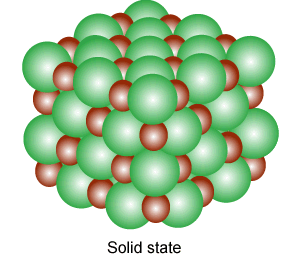A crystal is made up of metal ions 'M $_{1}$ ' and 'M $_{2}$ ' and oxide ions. Oxide ions. form a ccp lattice structure. The cation '$M_1$ occupies $50 \%$ of octahedral voids and the cation 'M $_{2}$ ' occupies $12.5 \%$ of tetrahedral voids of oxide lattice. The oxidation numbers of ' $M _{1}$ ' and ' $M _{2}$ ' are, respectively:
- $+2, +4$
- $+3, +1$
- $+1, +3$
- $+4, +2$
The Correct Option is A
Solution and Explanation
\(O ^{-2}\) ions form \(ccp\)
\(M _{1}=50 \%\) of \(O . V .\)
\(\Rightarrow \frac{50}{100} \times 4=2:\left( M _{1}\right)_{2}\)
\(M _{2}=12.5 \%\) of \(T.V .\)
\(\Rightarrow \frac{12.5}{100} \times 8=1:\left( M _{2}\right)\)
So formula is : \((M_{1})_{2} (M_{2})_{1} O_{4}\)
So , the correct answer is (A) : +2,+4
Top Questions on The solid state
- A metal crystallizes in simple cubic lattice. The volume of one unit cell is \( 6.4 \times 10^{-7} \, \text{pm}^3 \). What is the radius of the metal atom in pm?
- AP EAPCET - 2025
- Chemistry
- The solid state
- A metal crystallises in two cubic phases, fcc and bcc with edge lengths 3.5 Å and 3 Å respectively. The ratio of densities of fcc and bcc is approximately
- TS EAMCET - 2025
- Chemistry
- The solid state
- How many kinds of Bravais lattice are possible in a crystal?
- Bihar Board XII - 2025
- Chemistry
- The solid state
- The percentage of free space in a body-centred cubic unit cell is
- Bihar Board XII - 2025
- Chemistry
- The solid state
- The number of atoms present in body-centred cubic unit cell is
- Bihar Board XII - 2025
- Chemistry
- The solid state
Questions Asked in JEE Main exam
- The kinetic energy of translation of the molecules in 50 g of CO\(_2\) gas at 17°C is:
- JEE Main - 2025
- The Kinetic Theory of Gases
- Using the principal values of the inverse trigonometric functions the sum of the maximum and the minimum values of \(16((sec^{-1}x)^{2}+(cosec^{-1}x)^{2})\) is:
- JEE Main - 2025
- Inverse Trigonometric Functions
Consider the following sequence of reactions :

Molar mass of the product formed (A) is ______ g mol\(^{-1}\).- JEE Main - 2025
- Organic Chemistry
- A wire of resistance R is bent into an equilateral triangle and an identical wire is bent into a square. The ratio of resistance between the two end points of an edge of the triangle to that of the square is:
- JEE Main - 2025
- electrostatic potential and capacitance
In a Young's double slit experiment, three polarizers are kept as shown in the figure. The transmission axes of \( P_1 \) and \( P_2 \) are orthogonal to each other. The polarizer \( P_3 \) covers both the slits with its transmission axis at \( 45^\circ \) to those of \( P_1 \) and \( P_2 \). An unpolarized light of wavelength \( \lambda \) and intensity \( I_0 \) is incident on \( P_1 \) and \( P_2 \). The intensity at a point after \( P_3 \), where the path difference between the light waves from \( S_1 \) and \( S_2 \) is \( \frac{\lambda}{3} \), is:

- JEE Main - 2025
- electrostatic potential and capacitance
Concepts Used:
Solid State
Solids are substances that are featured by a definite shape, volume, and high density. In the solid-state, the composed particles are arranged in several manners. Solid-state, in simple terms, means "no moving parts." Thus solid-state electronic devices are the ones inclusive of solid components that don’t change their position. Solid is a state of matter where the composed particles are arranged close to each other. The composed particles can be either atoms, molecules, or ions.

Types of Solids:
Based on the nature of the order that is present in the arrangement of their constituent particles solids can be divided into two types;
- Amorphous solids behave the same as super cool liquids due to the arrangement of constituent particles in short-range order. They are isotropic and have a broad melting point (range is about greater than 5°C).
- Crystalline solids have a fixed shape and the constituent particles are arranged in a long-range order.